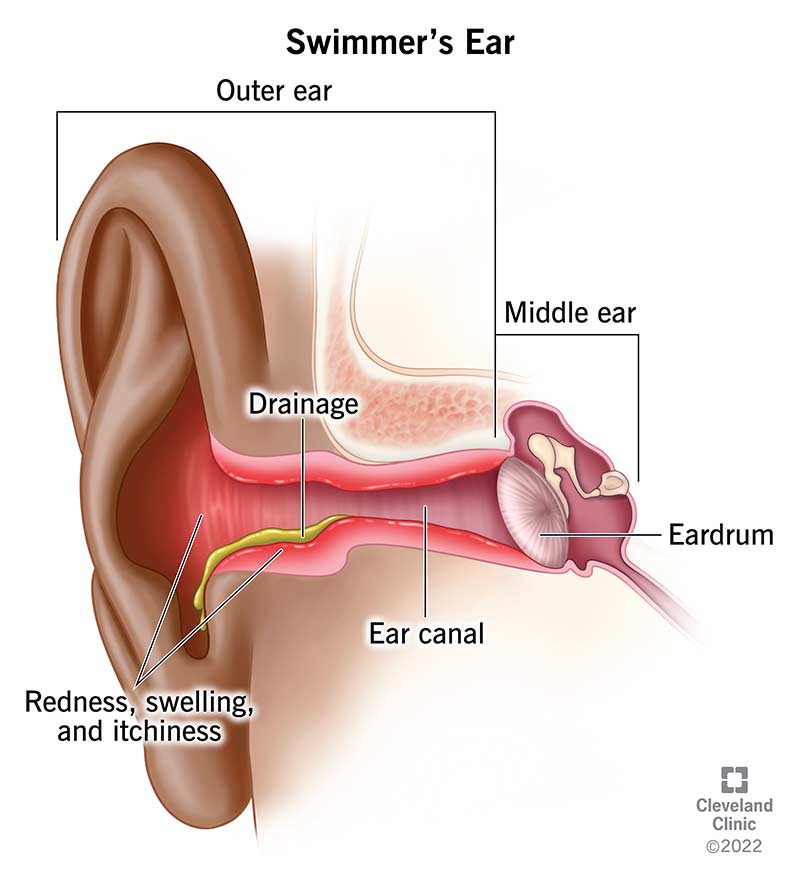Swimmer’s ear (also called otitis externa) is an ear infection in your ear canal, the pathway between your outer ear and your middle ear. Swimmer’s ear may be a bacterial or fungal infection. Healthcare providers treat swimmer’s ear with eardrops that eliminate the infection.

Swimmer’s ear (also called otitis externa) is an ear infection in your ear canal, the pathway between your outer ear and your middle ear. Swimmer’s ear may be a bacterial infection or fungal infection.
It’s called swimmer’s ear because many avid swimmers develop the condition at some point in their lives. But even people who rarely dunk their head in the pool, lake or ocean may develop swimmer’s ear. For example, skin conditions like psoriasis increase your risk of swimmer’s ear.
Left untreated, swimmer’s ear may affect your hearing, including causing hearing loss. Most of the time, treatment solves any hearing issues caused by swimmer’s ear. Healthcare providers treat swimmer’s ear with ear drops that eliminate the infection.
No, it won’t. Swimmer’s ear is an infection in your ear canal that won’t go away unless it’s treated. Left untreated, a swimmer’s ear infection may spread to the base of your skull, your brain or your cranial nerves.
Advertisement
Cleveland Clinic is a non-profit academic medical center. Advertising on our site helps support our mission. We do not endorse non-Cleveland Clinic products or services. Policy
Swimmer’s ear symptoms can be mild or severe, depending the infection in your ear. Symptoms may include:
Many things may cause swimmer’s ear, but the most common cause is activity that traps water in your ear canal. As bacteria and fungi thrive in warm, moist places, water pooling in your ear canal is the perfect environment for bacteria and fungi settle in, start multiplying and eventually cause infection.
Other causes include:
Advertisement
A provider will examine your ears for redness, swelling or other signs of damage. If your ears are draining, providers may take a sample of the drainage to determine what caused the infection. Bacterial infections and fungal infections require different treatment.
Providers may prescribe ear drops that contain antibiotics and corticosteroids. They typically recommend over-the-counter pain medication to ease pain.
Advertisement
Yes, there are things you can do to prevent swimmer’s ear. Keeping your ears dry is the most effective way to prevent swimmer’s ear.
Swimmer’s ear happens when there’s water trapped in your ear canal, creating a place for bacteria and fungi to multiply. Ways to dry your ears include:
Most people with mild swimmer’s ear feel better within seven to 10 days after starting treatment. If you have severe swimmer’s ear, it make take more time for medication to get rid of the infection.
Swimmer’s ear is an infection in your ear canal. If you’re receiving treatment for swimmer’s ear, you can take care of yourself by:
Sometimes, people confuse the term “swimmer’s ear,” which is an infection, and the experience of having water in their ear. You need treatment to eliminate an infection. But if you have water in your ear, you can and should dry your ear canal as much as possible so you don’t develop an infection. You can dry out your ear canal by:
You should see your healthcare provider if:
If you have swimmer’s ear, you may want to ask your provider the following questions:
A note from Cleveland Clinic
Swimmer’s ear is an infection in your ear canal. Typically, it affects people who spend a lot of time in the water. But you can develop swimmer’s ear when you shower, by using earbuds or hearing aids, or because you have certain skin conditions. Swimmer’s ear isn’t a serious condition but it’s an infection that left untreated may cause serious medical issues. If your ears hurt or feel itchy, talk to a healthcare provider.
Last reviewed on 11/15/2022.
Learn more about the Health Library and our editorial process.
Advertisement
Cleveland Clinic is a non-profit academic medical center. Advertising on our site helps support our mission. We do not endorse non-Cleveland Clinic products or services. Policy